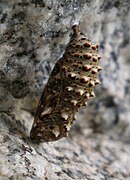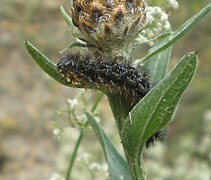|
Melitaea phoebe
Melitaea phoebe, also known as the knapweed fritillary,[1] is a butterfly of the family Nymphalidae.[2] It is found in the Palearctic realm, including most of Europe and North Africa, excluding the United Kingdom and Scandinavia. Previously, it also included Melitaea telona, which was recently revalidated as a distinct cryptic species.[citation needed] DescriptionM. phoebe butterflies have a wingspan of 34 to 50 mm. Their forewings are more pointed than the eastern knapweed fritillary, but are equally variable in color and distinctive markings. Their black markings are usually joined, but may instead cover a majority of the wing or very little of it. The species features a reddish-yellow submarginal lunate (crescent-shaped) spot between the two median veins that reaches its vertex, considerably farther into the disc than the other yellow lunate spots. This pattern is present on both the forewings and the hindwings. Additionally, the submarginal lunule between the 1st and 2nd median veins projects farther basal than the other lunules of the same row.[3] Wheeler (1903) gives a short description.[4]
M. phoebe pupa are a dull yellow-brown colour, with dark yellow and black markings. The larvae are grey with a black head, soft red-brown branched thorns, blackish dorsal lines, and numerous small white dots.[3] BiologyM. phoebe is active from April to September, depending on the location. The larvae feed on Plantago and Centaurea species (including Centaurea jacea).[citation needed] Distribution and habitatM. phoebe is present throughout Europe except for the northern regions such as England, Ireland, Northern France, Germany, Poland, Holland, Belgium and Scandinavia. It can also be found in North Africa: Morocco and Algeria, Turkey, Siberia, and Central Asia in Mongolia and northern China included.[citation needed] M. phoebe inhabits flowery meadows and plains, but may just also be found in stonier places such as rocky hills.[3][5] EtymologyNamed in the classical tradition, Phoebe is—in Greek mythology—one of the first generation of Titans, the children of Uranus and Gaia.[citation needed] The species Melitaea phoebe was described by entomologists Johann Nepomuk Cosmas, Michael Denis and Ignaz Schiffermüller in 1779, under the initial name Papilio phoebe. ReferencesWikimedia Commons has media related to Melitaea phoebe.
|
||||||||||||||||||||||||||||||||||||||||||
Portal di Ensiklopedia Dunia









